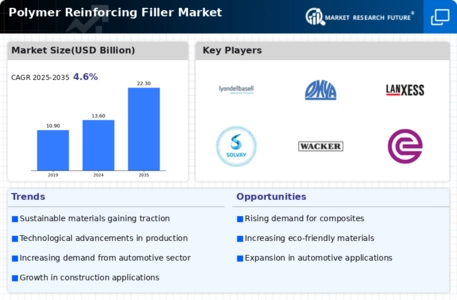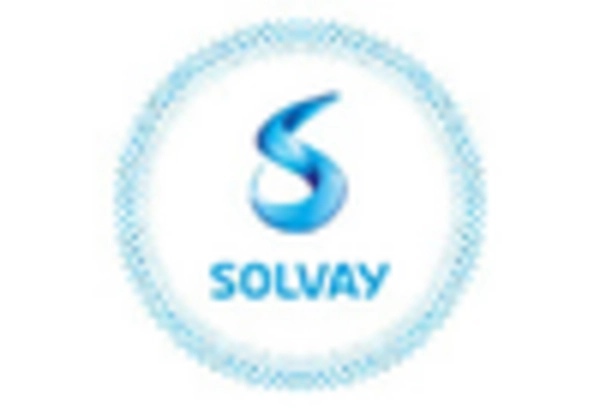Expansion of Automotive Sector
The expansion of the automotive sector is a critical driver for the Polymer Reinforcing Filler Market. As the automotive industry evolves, there is a growing emphasis on lightweight materials to improve fuel efficiency and reduce emissions. Polymer reinforcing fillers play a vital role in achieving these objectives by enhancing the mechanical properties of automotive components. The automotive market is anticipated to grow at a rate of approximately 5% annually, which could lead to increased demand for polymer fillers. This growth presents a significant opportunity for the Polymer Reinforcing Filler Market to cater to the needs of automotive manufacturers seeking to innovate and comply with stringent environmental regulations.
Advancements in Polymer Technology
Technological advancements in polymer science are significantly influencing the Polymer Reinforcing Filler Market. Innovations in filler formulations and processing techniques are enabling the development of more efficient and effective reinforcing agents. These advancements allow for better dispersion, compatibility, and performance of fillers in various polymer matrices. As a result, manufacturers are increasingly adopting these advanced fillers to enhance the mechanical properties of their products. The market is witnessing a shift towards high-performance polymers that incorporate specialized fillers, which could lead to a projected increase in market size by approximately 6% over the next few years. This trend underscores the importance of continuous research and development in the Polymer Reinforcing Filler Market.
Rising Demand for Lightweight Materials
The Polymer Reinforcing Filler Market is experiencing a notable increase in demand for lightweight materials across various sectors, including automotive and aerospace. This trend is driven by the need for improved fuel efficiency and reduced emissions. As manufacturers seek to enhance the performance of their products, the incorporation of polymer reinforcing fillers becomes essential. These fillers not only contribute to weight reduction but also improve mechanical properties, making them attractive for applications in composite materials. The market for lightweight materials is projected to grow significantly, with estimates suggesting a compound annual growth rate of over 5% in the coming years. This growth is likely to bolster the Polymer Reinforcing Filler Market as companies strive to meet regulatory standards and consumer expectations for sustainability.
Increasing Focus on Sustainable Practices
The Polymer Reinforcing Filler Market is increasingly influenced by the global focus on sustainability and eco-friendly practices. Manufacturers are under pressure to adopt sustainable materials and processes, leading to a rise in the use of bio-based and recycled fillers. This shift not only addresses environmental concerns but also meets consumer demand for greener products. The market for sustainable fillers is expected to grow, with projections indicating a potential increase of around 7% in the next few years. This trend presents an opportunity for the Polymer Reinforcing Filler Market to innovate and develop sustainable solutions that align with regulatory requirements and consumer preferences.
Growth in Construction and Infrastructure Development
The Polymer Reinforcing Filler Market is poised to benefit from the ongoing growth in construction and infrastructure development. As urbanization accelerates, there is an increasing demand for durable and high-performance materials in construction applications. Polymer reinforcing fillers are utilized in concrete, asphalt, and other building materials to enhance strength and longevity. The construction sector is projected to expand at a rate of approximately 4% annually, which could lead to a heightened demand for polymer fillers. This trend indicates a robust opportunity for the Polymer Reinforcing Filler Market to cater to the evolving needs of the construction industry, particularly in regions experiencing rapid urban growth.


















Leave a Comment